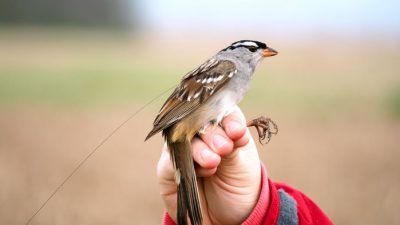Common Pesticide Makes Migrating Birds Anorexic

When birds migrate, timing is everything. Fly too late, and they miss the peak season for finding good food, a good mate, or a good nest site. But that’s just what may happen to migrants unlucky enough to eat pesticide-laced seeds, new research shows. Toxicologists studying white-crowned sparrows have shown that these large, grayish sparrows become anorexic after eating neonicotinoid pesticides, causing them to lose weight and delay their southward journeys. The study might apply to other birds as well—and help explain the dramatic songbird decline of recent decades, researchers say.
Neonicotinoids are the world’s most widely used class of pesticide. They protect seeds—and the plants that grow from them—from insects resistant to other pesticides. But scientists have recently found that they can decimate pollinators like honey bees and bumble bees. Such concerns led the European Union to ban three of these compounds in 2018.
Laboratory studies have shown that neonicotinoids sicken and disorient captive birds, but no data existed on how they affect wild birds, who often swoop into fields to nosh on pesticide-laced seeds. Wondering whether pesticide exposure might explain a massive recent decline in farmland bird species, Margaret Eng, an ecotoxicologist at the University of Saskatchewan in Saskatoon, Canada, and her colleagues got to work.
The researchers caught dozens of white-crowned sparrows (Zonotrichia leucophrys) in southern Ontario province in Canada as the birds migrated from the Arctic to the southern United States. They kept the birds in cages with food and water for 6 hours. About a dozen received low doses of the neonicotinoid imidacloprid—equivalent to what they might ingest had they eaten several seeds from a recently planted field. Another dozen got a lower dose of the pesticide, and control birds received the same handling but no pesticide. After 6 hours, Eng put a tiny radio transmitter on each bird’s back and released it into a 100,000-square-kilometer site in Ontario, where 93 regularly spaced radio towers track tagged animals.
Within hours, birds with the highest pesticide dose lost an average of 6% of their body weight and about 17% of their fat stores, which are key to fueling long flights, Eng and colleagues report today in Science. Over the course of those 6 hours, the birds given pesticides stopped eating, taking in about one-third the food that untreated birds ate, they note.
Nor did the birds recover quickly when released. Half of the high-dose birds stuck around Ontario an extra 3.5 days or longer. “It’s just a few days, but we know that just a few days can have significant consequences for survival and reproduction,” Eng explains. She thinks the birds needed that extra time to get the pesticide out of their systems, start to eat again, and regain their lost fat.
The paper provides “a compelling set of observations” that shows how even low doses of neonicotinoids can affect bird survival and reproduction, says Mark Jankowski, a toxicologist at the University of Minnesota in St. Paul who was not involved with the work. These effects could help explain declines in sparrow populations—and may apply to other birds, says Caspar Hallmann, an ecologist at Radboud University in Nijmegen, the Netherlands. But more work would be needed to prove that, Jankowski adds.
Few researchers think the United States or Canada will have the political will to ban neonicotinoids despite the harms, because they are so protective for plants. But there are workarounds, says Nicole Michel, a population biologist with the National Audubon Society’s Conservation Science Division in Portland, Oregon. For example, rather than treat all seeds before they are planted, farmers could save money and reduce birds’ exposure by applying the pesticide to plants only after an insect outbreak occurs. Jankowski says researchers could also explore other methods to reduce birds’ exposure, including coming up with better ways to bury seeds—and remove those that spill—during planting.
*
Note to readers: please click the share buttons above or below. Forward this article to your email lists. Crosspost on your blog site, internet forums. etc.
Elizabeth Pennisi is a senior correspondent covering many aspects of biology for Science.
Featured image: White-crowned sparrows stop eating after they ingest small amounts of neonicotinoid pesticides. (MARGARET ENG)

